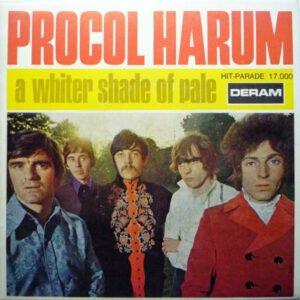September 18, 2020 —– Chart #57
Hello Musical Friends,
It’s Friday again, time to start the weekend. Looks like a beautiful one for those of us in Texas. Today’s Chart of the Day goes back to 1967 although the song remains popular today. “A Whiter Shade of Pale” is the debut single by the British rock band Procol Harum, released May 1967. The single reached number 1 in the UK Singles Chart on 8 June 1967 and stayed there for six weeks. Without much promotion, it reached number 5 on the Billboard Hot 100 chart in the United States. One of the anthems of the 1967 Summer of Love, it is one of the best-selling singles in history, having sold more than 10 million copies worldwide.
With its Bach-derived instrumental melody, soulful vocals, and unusual lyrics – by the song’s co-authors Gary Brooker, Keith Reid and Matthew Fisher – “A Whiter Shade of Pale” reached number 1 in many countries when released in 1967. In the years since, it has become an enduring classic. It was the most played song in the last 75 years in public places in the UK (as of 2009), and the United Kingdom performing rights group Phonographic Performance Limited in 2004 recognized it as the most-played record by British broadcasting of the past 70 years. Also in 2004, Rolling Stone placed “A Whiter Shade of Pale” 57th on its list of “The 500 Greatest Songs of All Time”.
In 1977, the song was named joint winner (along with Queen’s “Bohemian Rhapsody”) of “The Best British Pop Single 1952–1977” at the Brit Awards. In 1998 the song was inducted into the Grammy Hall of Fame. More than 1000 recorded cover versions by other artists are known. The song has been included in many music compilations over the decades and has also been used in the soundtracks of numerous films, including The Big Chill, Purple Haze, Breaking the Waves, The Boat That Rocked, House M.D., Martin Scorsese’s segment of New York Stories, Stonewall, Oblivion and Ken Burns and Lynn Novick’s documentary series The Vietnam War. Cover versions of the song have also been featured in many films, for example, by King Curtis in Withnail and I and by Annie Lennox in The Net.
The original writing credits were for Brooker and Reid only. On 30 July 2009, Matthew Fisher won co-writing credit for the music in a unanimous ruling from the Law Lords.
The song is in moderate time in C major and is characterized by the bassline moving stepwise downwards in a repeated pattern throughout. In classical music this is known as a ground bass. The harmonic structure is identical for the organ melody, the verse and the chorus, except that the chorus finishes with a cadence. The main organ melody appears at the beginning and after each verse/chorus. But it is also heard throughout, playing variations of its theme and counterpointing the vocal line. As the chorus commences “And so it was, that later …”, the vocal and organ accompaniment begin a short crescendo, with the organist running his finger rapidly down and up the entire keyboard. The final instrumental fades out to silence – a common device in pop music of the time.
The similarity between Hammond Organ line of “A Whiter Shade of Pale” and J.S. Bach’s Air from his Orchestral Suite No. 3 BWV1068, (the “Air on the G string”), where the sustained opening note of the main melodic line flowers into a free-flowing melody against a descending bass line, has been noted.
After “A Whiter Shade of Pale” became a hit, the band set out to consolidate its studio success by touring, with new official drummer Bobby Harrison added to the line-up; its live debut was opening for Jimi Hendrix in 1967. The group’s follow-up single, “Homburg”, with a line-up change of former Paramounts B. J. Wilson on drums and Robin Trower on guitar (replacing Harrison and Royer, respectively, who exited to form the band Freedom), reached No. 6 in the UK, No. 15 in Canada, and No. 34 in the US.
A very cool 2006 recording, outdoor with the Danish National Concert Orchestra:
And if you are curious, here is Bach – Orchestral Suite No. 3 in D major BWV 1068: https://youtu.be/oqU4rF_ysQo
Keep rockin’,
Stan
